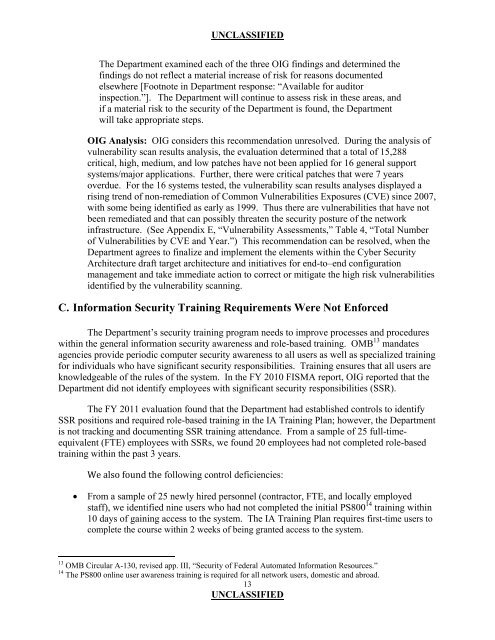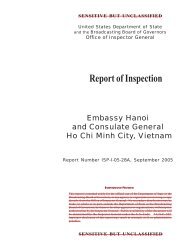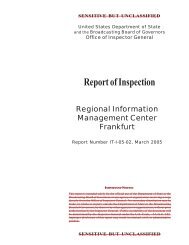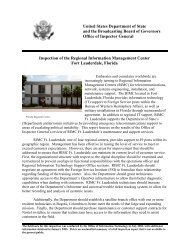Evaluation of Department of State Information Security Program ...
Evaluation of Department of State Information Security Program ...
Evaluation of Department of State Information Security Program ...
Create successful ePaper yourself
Turn your PDF publications into a flip-book with our unique Google optimized e-Paper software.
UNCLASSIFIED<br />
The <strong>Department</strong> examined each <strong>of</strong> the three OIG findings and determined the<br />
findings do not reflect a material increase <strong>of</strong> risk for reasons documented<br />
elsewhere [Footnote in <strong>Department</strong> response: “Available for auditor<br />
inspection.”]. The <strong>Department</strong> will continue to assess risk in these areas, and<br />
if a material risk to the security <strong>of</strong> the <strong>Department</strong> is found, the <strong>Department</strong><br />
will take appropriate steps.<br />
OIG Analysis: OIG considers this recommendation unresolved. During the analysis <strong>of</strong><br />
vulnerability scan results analysis, the evaluation determined that a total <strong>of</strong> 15,288<br />
critical, high, medium, and low patches have not been applied for 16 general support<br />
systems/major applications. Further, there were critical patches that were 7 years<br />
overdue. For the 16 systems tested, the vulnerability scan results analyses displayed a<br />
rising trend <strong>of</strong> non-remediation <strong>of</strong> Common Vulnerabilities Exposures (CVE) since 2007,<br />
with some being identified as early as 1999. Thus there are vulnerabilities that have not<br />
been remediated and that can possibly threaten the security posture <strong>of</strong> the network<br />
infrastructure. (See Appendix E, “Vulnerability Assessments,” Table 4, “Total Number<br />
<strong>of</strong> Vulnerabilities by CVE and Year.”) This recommendation can be resolved, when the<br />
<strong>Department</strong> agrees to finalize and implement the elements within the Cyber <strong>Security</strong><br />
Architecture draft target architecture and initiatives for end-to–end configuration<br />
management and take immediate action to correct or mitigate the high risk vulnerabilities<br />
identified by the vulnerability scanning.<br />
C. <strong>Information</strong> <strong>Security</strong> Training Requirements Were Not Enforced<br />
The <strong>Department</strong>’s security training program needs to improve processes and procedures<br />
within the general information security awareness and role-based training. OMB 13 mandates<br />
agencies provide periodic computer security awareness to all users as well as specialized training<br />
for individuals who have significant security responsibilities. Training ensures that all users are<br />
knowledgeable <strong>of</strong> the rules <strong>of</strong> the system. In the FY 2010 FISMA report, OIG reported that the<br />
<strong>Department</strong> did not identify employees with significant security responsibilities (SSR).<br />
The FY 2011 evaluation found that the <strong>Department</strong> had established controls to identify<br />
SSR positions and required role-based training in the IA Training Plan; however, the <strong>Department</strong><br />
is not tracking and documenting SSR training attendance. From a sample <strong>of</strong> 25 full-timeequivalent<br />
(FTE) employees with SSRs, we found 20 employees had not completed role-based<br />
training within the past 3 years.<br />
We also found the following control deficiencies:<br />
� From a sample <strong>of</strong> 25 newly hired personnel (contractor, FTE, and locally employed<br />
staff), we identified nine users who had not completed the initial PS800 14 training within<br />
10 days <strong>of</strong> gaining access to the system. The IA Training Plan requires first-time users to<br />
complete the course within 2 weeks <strong>of</strong> being granted access to the system.<br />
13<br />
OMB Circular A-130, revised app. III, “<strong>Security</strong> <strong>of</strong> Federal Automated <strong>Information</strong> Resources.”<br />
14<br />
The PS800 online user awareness training is required for all network users, domestic and abroad.<br />
13<br />
UNCLASSIFIED








